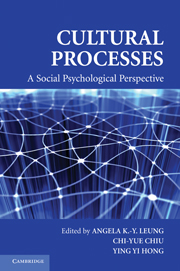Book contents
- Frontmatter
- Contents
- Figures and Tables
- Contributors
- Preface
- Part One Introduction
- Part Two Representational theories of culture
- Part Three Psychological functions of culture
- Part Four Manifestations of cultural processes
- Part Five Transcultural processes
- 12 Bicultural Identity Negotiation
- 13 Multicultural Experiences and Intercultural Communication
- 14 Multicultural Experience Fosters Creative Conceptual Expansion
- 15 Workforce Diversity and Creativity: A Multilevel Analysis
- Index
- References
14 - Multicultural Experience Fosters Creative Conceptual Expansion
Published online by Cambridge University Press: 05 June 2012
- Frontmatter
- Contents
- Figures and Tables
- Contributors
- Preface
- Part One Introduction
- Part Two Representational theories of culture
- Part Three Psychological functions of culture
- Part Four Manifestations of cultural processes
- Part Five Transcultural processes
- 12 Bicultural Identity Negotiation
- 13 Multicultural Experiences and Intercultural Communication
- 14 Multicultural Experience Fosters Creative Conceptual Expansion
- 15 Workforce Diversity and Creativity: A Multilevel Analysis
- Index
- References
Summary
Before you read on, take two minutes to draw a picture of an innovative kind of chocolate. Don't think too hard. Just draw it quickly.
This task was presented to the many designers, artists, and students from all over the world who took part in the Belgian chocolate initiative project organized by the Addict Creative Lab. When the famous Belgian chocolate company Isis Luxury approached this ethnically and functionally diverse group to brainstorm product branding and packaging strategies to enhance the product's marketability, Giovanna Massini, the Addict Creative Lab researcher who led the chocolate project, advised his lab members: “Chocolate in Belgium is an icon, like pasta in Italy. But why do we feel obliged by tradition? We must disturb the traditional shapes. We must create new combinations, new ingredients.”
- Type
- Chapter
- Information
- Cultural ProcessesA Social Psychological Perspective, pp. 263 - 285Publisher: Cambridge University PressPrint publication year: 2010
References
- 3
- Cited by



